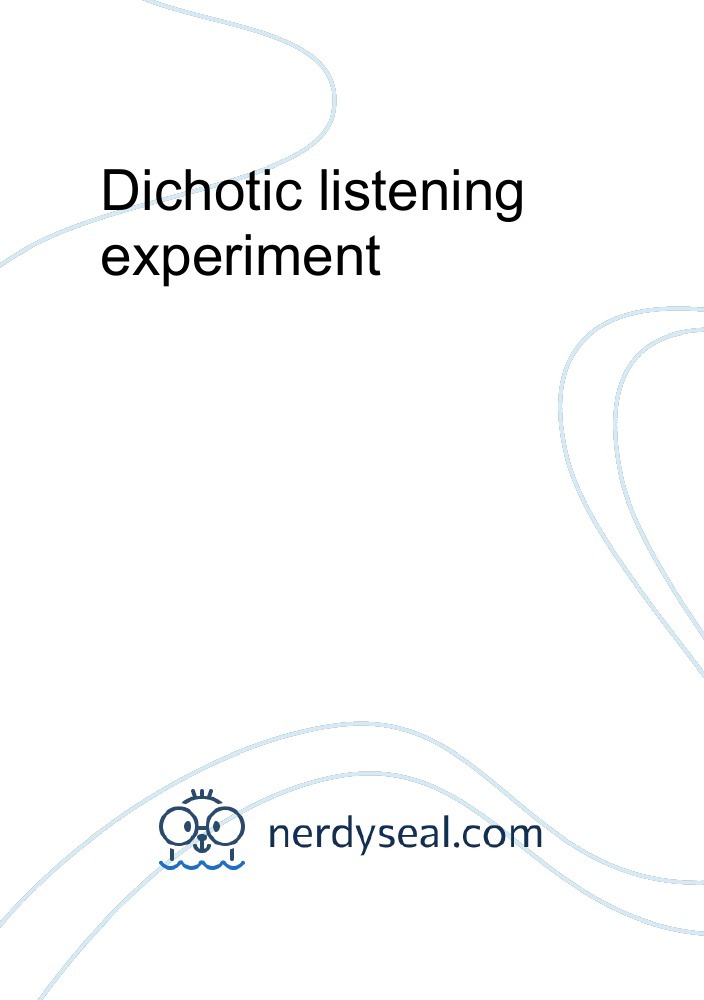

Dichotic listening psychology definition serial#
Given the existence of such a preattentive memory store makes it possible for preattentive stimuli to work in a serial manner. The aforementioned represent visual and auditory memory respectively, which function preattentively. A major component of the system entails sensory memory, which is broken down into iconic memory and echoic memory. This system compensates for the controversies of limited parallel processing in Broadbent’s original findings. Accuracy of their answers dropped significantly, which again supports Broadbent’s filter theory and an early selection model because switching from ear to ear is difficult and goes against the filter.Īs psychological research has improved immensely since Broadbent’s time, more sophisticated measures indicate that we do have an attentional filter, though it is integrated into a broader cognitive system. Participants were then told to repeat the letters in the order they were presented. This supports Broadbent’s filter theory and an early selection model because participants filtered the information based on ear. It resulted in reporting the letters presented to one ear first and then the letters presented from the other ear. Broadbent used this paradigm in his split-scan experiments, in which he presented participants with different letters in each ear simultaneously and instructed them to repeat them in any order. Following the listening period, the participants are tested on whether they recall any information presented in the unattended channel.Įarly research using dichotic listening tasks provided empirical evidence of participants’ ability to correctly recall information to the attended channel, and poor recalling in the unattended channel. The participant is instructed to attend (attended channel) the information coming from one of the ear pieces and neglect (unattended channel) the information presented from the other. In a typical dichotic listening paradigm, the participant is wearing a headphone, in which a different auditory stimuli are presented to each ear at the same time, and the participant’s attention is divided. It is widely used as it is a non-invasive method of testing cerebral dominance. This task has been used extensively to test numerous psychological phenonomena such as response times of specific auditory information, as well as testing for attended and unattended information presented to a participant. Filter theory reflects an early selection theory because certain information is selected and attended to at a very early stage of information processing.ĭuring his experimentation, Broadbent made use of the dichotic listening test. Information selected to pass through the filter is then available for short-term memory and manipulation of the selected information, prior to storage in long-term memory.įilter theory then postulates that a selective filter is needed to cope with the overwhelming amount of information entering the channels, such that certain messages must be inhibited or filtered out from the messages that were filtered for further processing. If one is attempting to attend to a stimulus based on their current goals, they will employ voluntary attention whereas if a sensory event catches one’s attention, reflexive attention will be employed. Channel selection is guided through attention. When developing his model, Broadbent emphasized the splitting of incoming stimuli to attended or unattended channels. Further, goal-directed behaviour requires attention to be controlled hence a high degree of selectivity is put forth in the information-processing stream. Therefore, based on physical characteristics, the selective filter allows for certain stimuli to pass through the filter for further processing, while unattended stimuli will be filtered out and lost. Unlike the physical properties, Broadbent believed semantic features, due to their complexity, would impose a limited capacity on the temporary storehouse of incoming stimuli.


These basic characteristics can include pitch, color, loudness, and direction.

Broadbent stated that all stimuli are processed initially for basic, physical properties. Broadbent was the first to describe human’s processing system using an information processing metaphor In this view, Broadbent proposed an early selection view of attention, such that humans process information with limited capacity and select information to be processed early.ĭue to this limited capacity, a selective filter is needed for information processing. Donald Broadbent based the development of the filter model from findings by Cherry, which was concerned with the issue of selective attention.


 0 kommentar(er)
0 kommentar(er)
